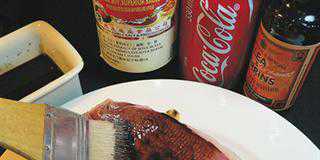
To make a couple of jars of mango pickle, you will need:
- 12 whole green mangoes
- 12 black peppercorns
- 1 tablespoon mustard powder
- 1 tablespoon salt
- 250ml sunflower, canola or peanut oil
- 1 entire garlic bulb
- 6 green chillies
- 180ml brown vinegar
- 5 tablespoons methi masala
For the methi masala
- 100g whole methi (fenugreek) seeds
- 100g coarse salt
- 6g tumeric powder
- 100g dried red chillies
- 15g asafoetida (also known as ‘ling’)
- 150ml sunflower oil
- 1 whole red chilli
We begin with the methi (fenugreek) masala. If you find that becoming a mango pickler is going to be a permanent part of your future cooking identity, you can make a bigger batch of methi masala by increasing the quantities. The secret is in the proportions. It will retain its properties over time, in a well-sealed bottle. To make the masala, coarsely crush the methi seeds and the dried chillies. Next, select a large saucepan and pour in the oil. Bring up the heat and add the whole red chilli. Lower the heat and add the crushed methi seeds.
Try out: A Durban mutton curry bunny chow
Stir well, then add salt. Stir vigorously again for a minute or so, and add all the other ingredients except for the asafoetida.
For the next 15 minutes, stir the pot briefly every minute, and then remove it from the heat. Add the asafoetida and let the masala cool before bottling it in a jar.It’s mango time! I assume the mangoes you have chosen are unbruised. Peel them carefully, removing as little of the fruit as possible. Dump the peels, then cut the fruit away from the pip into slices about 3mm thick and as long as your thumb.
When cutting the green fruit from the pip, take care not to include any of the pip in the final mix as it will contaminate the final production with its excessively sour taste. Choose a large mixing bowl and pour the mango slices, the rest of the ingredients and the methi masala into it. With a wooden spoon, mix it all well together.
Try out: Lamb curry
Cover the bowl with cling wrap or aluminium foil. For the next three days, mix the contents twice a day. At this point, it’s ready to eat or store like any other preserve. Use sterilised jars and lids when bottling the surplus, taking care to fill to the top. Refrigerate the jar and contents once it is opened. Quite honestly, I have no idea about the storage life. No matter how much of this magnificent taste enhancer I make, all of it is consumed rapidly. That’s hardly surprising – it’s one hell of a blast of flavour!













